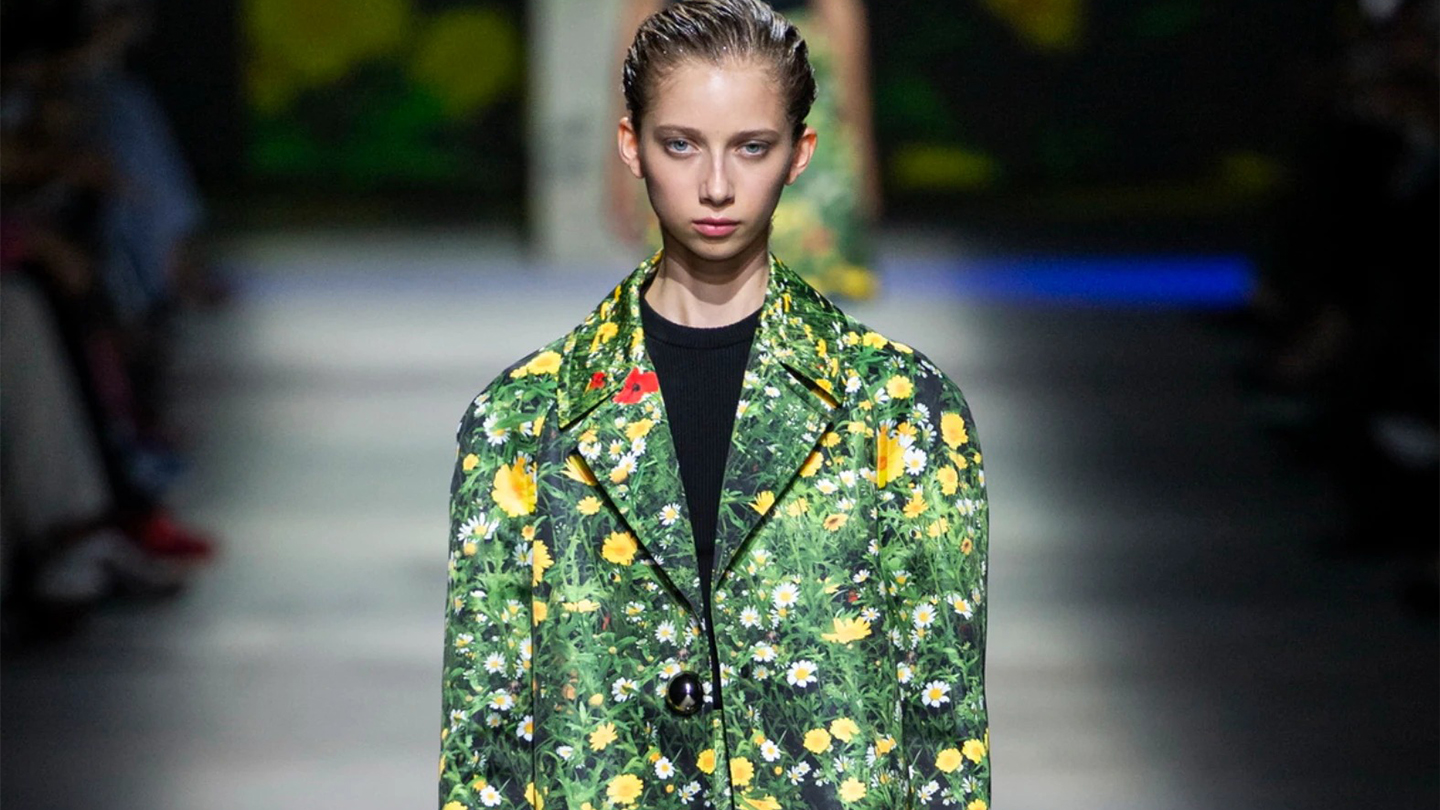Christopher Kane’s SS20 collection was provocatively titled “Ecosex”. The designer described ecosexuals as those who “Love the planet, who love to make love to the planet, who are naturists, who don’t need clothes, who just want flowers, beauty, nature and wind and magic and spirituality.”
While fashion has always been inspired by nature and sex, the title of Kane’s collection references a specific subcultural movement that has been gaining traction over the past decade, partly due to sensationalist headlines about people wanting to have sex with trees. Borrowing inspiration from niche sexual communities then giving them a playful twist is a hallmark of Kane’s brand. His previous collection, drew from the 1970s illustrated manual The Joy of Sex, focusing on people who are turned on by balloons, rubber and the smearing of food and drink. Both collections inspired tongue-in-cheek reactions. In his review of the “Ecosex” collection, fashion critic Tim Blanks allows readers a “pause to allow your imagination to run riot” about all the things people could do that involve, “literally [loving] the Earth.”
It’s estimated by some that around 50,000 people worldwide identify as ecosexual. The Ecosexual Manifesto, by Annie Sprinkle and Beth Stephens, describes some of the varied meanings that ecosexuality can have. There is no single definition. It is sexual identity, activism, sensuality and art, but above all ecosexuality is about treating the Earth with love and respect.
Annie and Beth married the Earth back in 2008 in a ceremony among the redwood trees of Santa Cruz, where their bridal parties and performance artists dressed in flowers and feathers, others covering themselves in soil. The wedding itself had an enchanted, otherworldly atmosphere, but Annie’s thoughts on ecosexual fashion are pragmatic. “As an ecosexual person, I would say I’d like to see clothes that are more sustainable, that don’t pollute, that are not made of petroleum products, that celebrate the sensuality and the beauty of the nonhuman world and that are lasting and recyclable.”
Christopher Kane’s “Ecosex” collection used tulle, silicone and lace, the eco-credentials of which are not known. He did, however, insist after the show that it was not intended as a comment on the climate crisis.
The fashion industry often stages grandiose displays of nature’s beauty that do more harm to the Earth than good. Lest we forget that in 2018, several century-old oak and poplar trees were cut down for a Chanel show which focused on Karl Lagerfeld’s love of nature. However, the industry is slowly learning from these mistakes. Dior’s SS20 runway was lined with 100 trees, all of which will be donated to community garden projects. This approach of revering nature’s aesthetic value but caring for it at the same time is at the core of ecosexuality.
Loren Kronemyer and Ian Sinclair are the duo behind Pony Express, the art collective that created Ecosexual Bathhouse, a multi-sensory experience that encourages participants to reconsider their relationship with the Earth. The show includes stroking orchids with finger condoms and earthy glory holes to sink your hands into. Loren explains that, “An ecosexual fashion sensibility aligns with do-it-yourself, do-it-together, circular economies, integration, experimentation and play. For our project, we had a mandate to use majority-recycled material for the creation of the fetish gear, sex toys, and costumes used in the work.”
Matthew Needham is one young designer whose ethical goals are key to his design vision and have been instrumental in his early success. Matthew makes his clothes from trash and deadstock, respecting the planet by not taking from its depleted resources but using what is already there. “The fashion industry is notorious for exploiting subcultures,” he says. “Ecosexuality is another example of that. Look at club kids and drag. It’s always happened because it sells.”
Though creatives like Kane are able to approach their chosen topics with a lighthearted touch, when floods and fires are happening across the globe, is there a place for fashion that looks at ecosexuality from such a frivolous standpoint? Sustainable fashion consultant, Alice Wilby says that, “The fetishisation of environment all for the sake of selling clothes feels like a grotesque gimmick. It highlights how deeply out of touch with the environmental crisis these designers are when they are using it as a means to shift clothing.”
Orsola de Castro, Founder and Creative Director of Fashion Revolution thinks that the severity of the climate crisis means that using the word sexy in relation to it is both inappropriate and dangerous. “I don’t think that you can talk about people dying and forest fires and — just because you have a product that makes you look good — use the word sexy,” she explains. “When I see people from Extinction Rebellion going to the streets, I would consider that to be ecosexuality in a way. You’re lending your body and your voice to mingle with other people for a profoundly moving affect which is change, but that’s a bit deeper than ecosexy.”
Sustainability may now be trendy, but is it sexy? And does it need to be? The truth is, sex sells. It grabs people’s attention immediately without needing to have a transparent explanation about materials and production line along with it. Perhaps merging sexuality with environmentalism is a step in the right direction for fashion, as long as it is backed up by clear sustainability policies that are transparent to customers and strictly-enforced.

